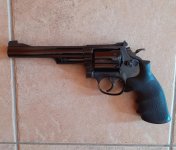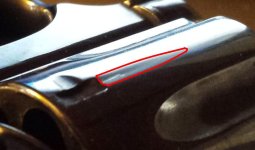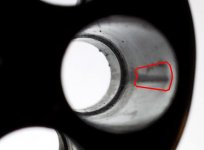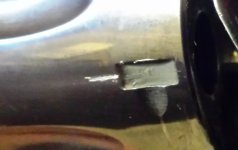Belgian686
Member
Hi, I would need some advice of you about following :
Someone is selling a used 19-3 6" for about 160 $, honestly claiming the gun has had an overpressure issue in one of it's chambers. There is nothing visible, but his concern is that one of the chambers is very sticky, to the point he has to drive out empties with a hammer and punch. He took the gun back after the first shooting to the gunsmith who sold him the gun, and the guy doesn't want to take back the gun. I do not know yet if the issue comes up with .357 of .38 Spl.
The seller is very honest in the sense he states it clearly on the sales ad. I don't judge the gunsmith, and I do not know his arguments for not taking it back. I personally wouldn't buy at his place for his hugely overpriced items.
My question : can this very sticky chamber on a19-3 (made in years where QC was still perfect) be a matter of overpressure ?
I am very skeptical about this. In Belgium, it's nearly impossible to find a replacement cylinder for this gun, so swapping parts is not an option. But can it be considered to use the gun as range gun (anyway the only option here - carrying is completely out of possibilities), even loading only 5 chambers (and marking the chamber with the "issue" with some red paint, not visible when closed) ?
Thanks a lot for your opinions on this.
Someone is selling a used 19-3 6" for about 160 $, honestly claiming the gun has had an overpressure issue in one of it's chambers. There is nothing visible, but his concern is that one of the chambers is very sticky, to the point he has to drive out empties with a hammer and punch. He took the gun back after the first shooting to the gunsmith who sold him the gun, and the guy doesn't want to take back the gun. I do not know yet if the issue comes up with .357 of .38 Spl.
The seller is very honest in the sense he states it clearly on the sales ad. I don't judge the gunsmith, and I do not know his arguments for not taking it back. I personally wouldn't buy at his place for his hugely overpriced items.
My question : can this very sticky chamber on a19-3 (made in years where QC was still perfect) be a matter of overpressure ?
I am very skeptical about this. In Belgium, it's nearly impossible to find a replacement cylinder for this gun, so swapping parts is not an option. But can it be considered to use the gun as range gun (anyway the only option here - carrying is completely out of possibilities), even loading only 5 chambers (and marking the chamber with the "issue" with some red paint, not visible when closed) ?
Thanks a lot for your opinions on this.




